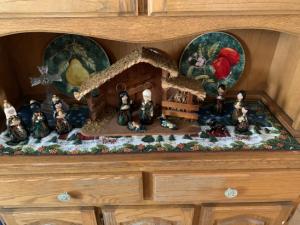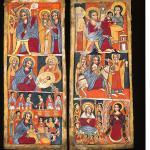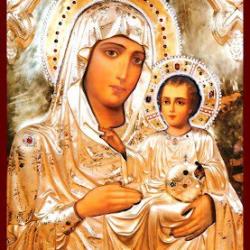My first Christmas creche from infancy is in my home office, our children’s first creche (minus a broken wiseman, 2020 was hard) is in our den, and our newest sits in the dining room giving us another view of one of history’s greatest events. There was an experiment with what one adult child calls the “bling nativity” but the less said about this the better. The handwritten nativity icon on our wall fills our house with Christmas all year.
One could have filmed the Nativity, but given ancient Roman technology and all that, nobody did. Instead, God gave us different ways of thinking about His birth as the man Jesus from the very theological in John to the ancient history in Luke. Over the centuries great artists and iconographers gave us other inspired images to help show one aspect or another of the end of our loneliness and the beginning of the restoration of people to God.

I spent some time looking at our new creche and learning the lessons the artist was teaching:
Different artists, different lessons.
And that was good for my soul. I shan’t share most of those thoughts just yet, as they are new, and require more thinking. The most obvious was the importance of seeing the work of artists from many places, times, and cultures. This is not because some propositional truth will change: Christ was born! Glorify Him! Both statements are true in every way that a proposition can be true.
When I was a boy, looking at that first creche, the thought: “Jesus was born,” was just so. I do not deny that truth in looking at the work of a very different artist, but I might see further truths that cluster around that original truth or experience that truth in a new way. How did the great truth of God becoming man look to this artist? How did he or she live that experience? Does that give me an access to different passions, new emotions, broader beauty? Surely!
No artist is perfect, so we must check our first responses eventually, but generally when we see beauty our response is love and there is nothing to fear in love as love. We glory or at least enjoy the moment and then reflect. After all the sense of an Orthodox nativity icon can change, the lessons multiply, as one looks at the same basic pattern from Russia, Greece, Ethiopia (Aksum!), Japan, or countless other nations and sees and feels something different.
![]() A mistake I made when digital copies of music became available was (stupidly) thinking that I could buy a “perfect” version of a Tchaikovsky’s All Night Vigil. My musician friends taught me that there was no such thing. Each performance stood apart and even an imperfection, a flawed performance, as a human act of worship, enhanced what I knew and experienced. Most were not “flawed” at all, but different expressions of the same work of art. The chanted liturgy I heard in a chapel of the Martyred Tsar in Tsarkoye Selo and last Sunday at dear Saint George were the same, yet different. My experience of both was different as were the truths revealed in the liturgy and the sermon.
A mistake I made when digital copies of music became available was (stupidly) thinking that I could buy a “perfect” version of a Tchaikovsky’s All Night Vigil. My musician friends taught me that there was no such thing. Each performance stood apart and even an imperfection, a flawed performance, as a human act of worship, enhanced what I knew and experienced. Most were not “flawed” at all, but different expressions of the same work of art. The chanted liturgy I heard in a chapel of the Martyred Tsar in Tsarkoye Selo and last Sunday at dear Saint George were the same, yet different. My experience of both was different as were the truths revealed in the liturgy and the sermon.
This is a lived education and cultivation of the work of the inner heart.
The trouble with those who oppose patriotism, love of country, is that they cannot touch the authentic experience of a people. God help any person who loves generic “persons” but does not know the lives of women and men who live in the villages of Greece, metropolitan Moscow, or the high-rises of Addis Ababa. They love their families, their experiences, and their very own nations as they are commanded to do. This love of homeland produces folk art that eventually produces the genius who makes the particular work of that nation sublime, transcendent, and globally vital.
We begin in the creche of childhood, learn to love our folkways, but this love will inevitably lead to other loves. Love knows no fear. Love begins with the beloved and ends straining to see the Universal Beloved. The small is the forerunner to the Great. The better we love the small, the more we will recognize other small loves, and join with those lovers to see the Beloved.
All God’s people have something to teach us.
This Christmas may we cling joyfully to the customs of our nation, people, or group. Let’s also gain a few new images, new experiences, expand our palate, learn from different voices, and so move closer to the great City of God to come. The different icons of Christmas, some familiar, some new, become signposts to the one Truth, one Beauty, one Good.












